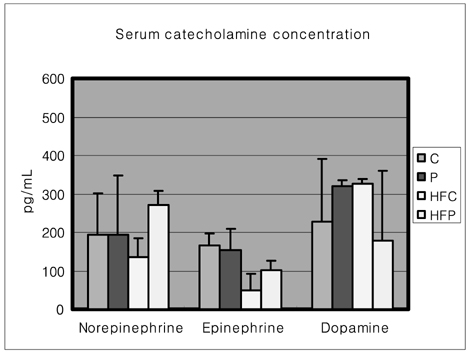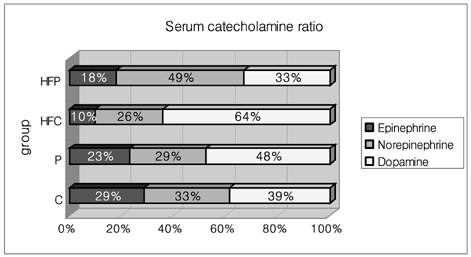Nutr Res Pract.
2007 Dec;1(4):291-297.
Effect of dietary soluble fiber on neurohormonal profiles in serum and brain of rats
- Affiliations
-
- 1Department of Food & Nutritional Science, Kyungnam University, Masan 631-701, Korea. shinds@kyungnam.ac.kr
Abstract
- This study was conducted to investigate the effect of dietary soluble fiber administration and /or high fat diet on serum and brain neurohormonal profiles, adipose tissue mass and body weight gain in Sprague-Dawley rats. Four groups of rats were respectively fed 10% fat diet (C), 10% fat plus pectin diet (P), 20% fat diet (HFC) and 20% fat plus pectin diet (HFP) for 4 weeks. In HFP group, the food and energy intake, body weight gain, FER including fecal excretion were the smallest (p<0.05). Serum HDL-cholesterol, triglyceride and glucose level were also the lowest in HFP group (p<0.05). The weight of brain, epididymal fat pad and adrenal gland except liver didn't show any significant differences among groups. Interestingly serum norepinephrine concentration of HFP group tended to be higher, but dopamine concentration tended to be lower than those of HFC group. However serum catecholamine concentration didn't show any significant differences among all groups. Norepinephrine and epinephrine contents of right portion of midbrain of P and HFP groups were remarkably lower than those of the C group. These results suggested that soluble fiber pectin consumption might affect neurohormonal profiles in serum and brain according to dietary fat level.
Keyword
MeSH Terms
Figure
Reference
-
1. Artiss JD, Brogan K, Brucal M, Moghaddam M, Jen KLC. The effects of a new soluble dietary fiber on weight gain and selected blood parameter in rats. Metab Clin Exp. 2006. 55:195–202.
Article2. Bell DG, Jacobs I, Ellerington K. Effect of caffeine and ephedrine ingestion on anaerobic exercise performance. Med Sci Sports Exerc. 2001. 33:1399–1403.
Article3. Bligh EG, Dyer WJ. A rapid method of total lipid extraction and purification. Can J Biochem Physiol. 1959. 67:911–917.
Article4. Bray GA. Drug treatment of obesity. Endocrine & Metabolic Disorder. 2001. 2:403–418.5. Cooper R, Morre DJ, Morre DM. Medical benefits of green tea: Part I. Review of noncancer health benefits. J Alter Compl Med. 2005. 11:521–528.
Article6. Food and Nutrition Board, Institute of Medicine. Dietary reference intakes for energy, carbohydrate, fiber, fat, fatty acids, cholesterol, protein and amino acid. 2002. Washington DC. USA: National Academy Press.7. Friedewald WT, Levey RI. Estimation of the concentration of low-density lipoprotein cholesterol in plasma, without use of the preparative ultracentrifuge. Clin Chem. 1972. 18:499–502.
Article8. Grundy SM. The optimal ratio of fat-to-carbohydrate in the diet. Ann Rev Nutr. 1999. 19:325–341.
Article9. Howarth N, Saltzman E, Roberts S. Dietary fiber and weight reduction. Nutr Rev. 2001. 59:129–139.10. Heck A, Yanovski J, Calis K. Orlistat, a new lipase inhibitor for the management of obesity. Pharmacotherapy. 2000. 20:270–279.
Article11. Jo MW, Shin DS. Effects of dietary fat level and pectin on body weight, vitamin A storage and serum catecholamine profiles in growing rats. J Basic Sciences. 2006. 23:77–87.12. Kim IW, Shin DS. Effects of diet with apple feel powder on serum lipid concentration in growing Sprague-Dawley rats. J Basic Sciences. 2002. 16:75–88.13. Leibowitz SF. Brain monoamines and peptides: Role in the control of eating behavior. Fed Proc. 1986. 45:1396–1403.14. Lim BO, Yamada K, Nonaka M, Kuramoto Y, Hung P, Sugano M. Dietary fibers modulate indices of intestinal immune in rats. J Nutr. 1997. 127:663–667.15. Morier-Teissier E, Rips R. Catecholamine metabolite measurement in mouse brain using high-performance liquid chromatography and electrochemical detection: Comparison of a one-column technique with a two-switching technique. J Chromatogr. 1984. 311:535–549.16. Martini FH, Ober WC, Garrison CW, Welch K, Hutchings RT. Fundamentals of Anatomy and physiology. 1995. 3th Ed. NJ. USA: Prentice-Hall International Inc.;410.17. Mcguire M, Beerman KA. Nutritional Sciences: from fundamentals to food. 2007. Bermont. USA: Thomson;135–137.18. McKevoy GK. AHFS Drug Information. 1998. Bethesda, MD. USA: American Society of Health-system Pharmacist.19. National Institute of Health & National Heart. Lung and Blood Institute. National Institute of Health Publication Number 00-4084. Clinical guideline on the identification, evaluation and treatment of overweight and obesity in adults-the evidence report. 2000. Benethda, MD. USA:20. National Research Council. Guide for the Care and Use of Laboratory Animals. 1996. Washington DC, USA: National Acadeny Press.21. Nussy SS, Whitehead SA. Catecholamine systhesis and secretion. Endocrinology, An intergrated approach. 2001. Taylor & Francis;470.22. Park CL. Banaba and corosolic acid-strong candidate for typeII DM. Neutraceuticals and functional foods for diabetes and obesity. 2005. Seoul. Republic of Korea: BFN.23. Pesce AJ, Kapla LA. Catecholamine-plasma. Methods in clinical chemistry. 1987. Missouri. USA: C.V. Mosby;946–947.24. Pittler M, Ernst E. Dietary supplements for body-weight reduction: a systemic review. Am J Clin Nutr. 2004. 79:529–536.25. Reynisdottir S, Wahrenberg H, Carlstrom K, Rossoner S, Arner A. Catecholamine resistance in fat cells of women with upper-body obesity due to decreased expression of beta2-adrenoreceptors. Diabetologia. 1994. 37:428–435.
Article26. Reeves PG, Nielsen FH, Fasey GC. AIN-93 purified diets for laboratory rodents: final report of the American Institute of Nutrition ad hoc writing committee on the reformulation of the AIN 76A rodent diet. J Nutr. 1993. 123:1939–1951.
Article27. Shimizu H, Bray A. Effects of neuropeptide on norepinephrine and serotonin metabolism in rat hypothalamus in vivo. Brain Res Bull. 1989. 22:945–950.
Article28. Spiegelman BM, Flier JS. Obesity and regulation of energy balance. Cell. 2001. 23:531–543.29. Swartz MW, Woods SC, Orte D, Baskin DG. Central nervous system of food intake. Nature. 2000. 404:661–671.30. Quay WD, Timira PS, Vernadakis A. Amine secreting endocrines. Hormone and aging. 1995. NY. USA: CRC;67.
- Full Text Links
- Actions
-
Cited
- CITED
-
- Close
- Share
- Similar articles
-
- Preparation of Soluble Dietary Fiber from Oak Wood (Quercus Mongolica) and Its Physiological Function in Rat Fed High Cholesterol Diets
- Effect on Diarrhea of Dietary Soluble Fiber Added to Nasogastric Tube-Fed Formulas in Stroke or Traumatic Brain Injury Patients
- Analysis of dietary insoluble and soluble fiber contents in school meal
- The effect of seamustard on blood lipid profiles and glucose level of rats fed diet with different energy composition
- Effect of dietary fats on immune response in rats



